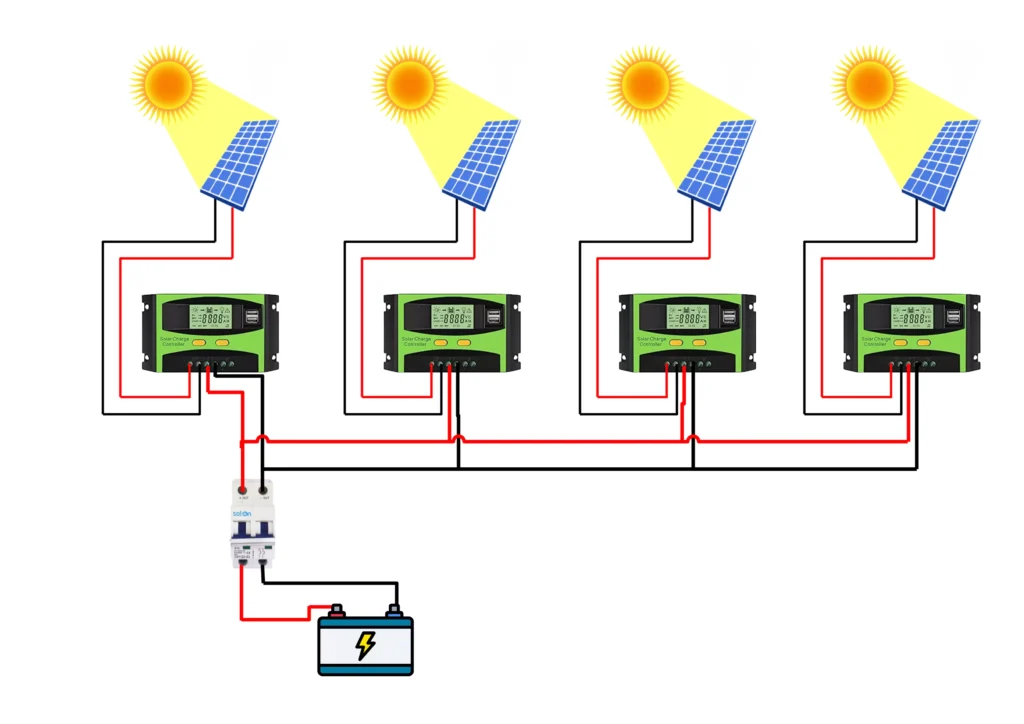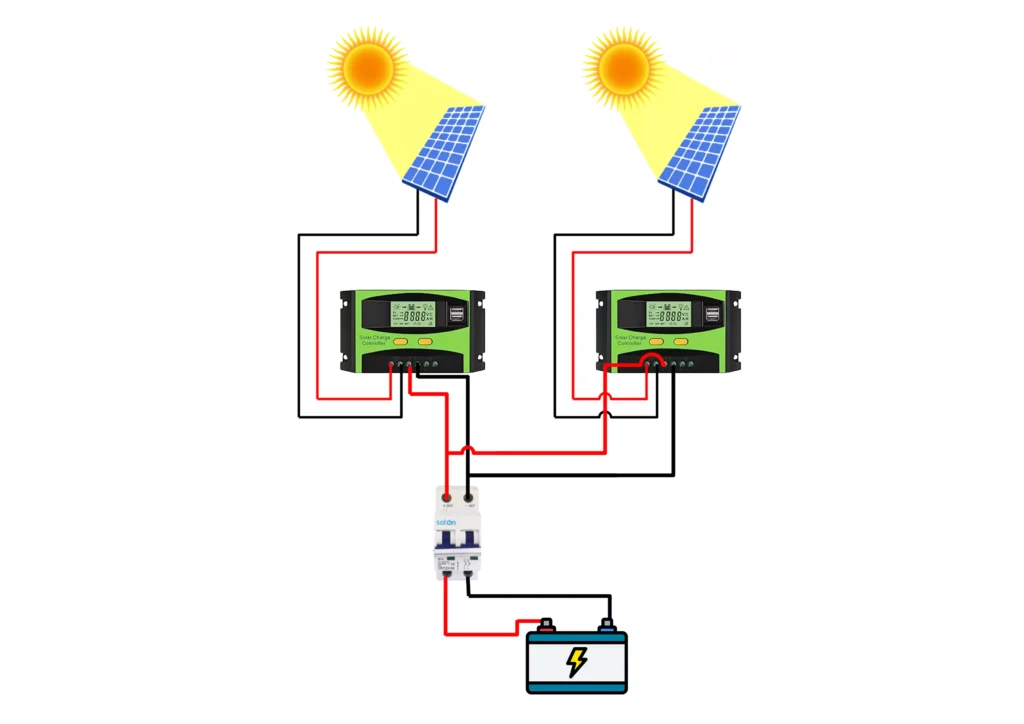Wire Multiple Solar charge Controllers (With Diagram)
A charge controller or charge regulator is a device that manages the flow of electricity from solar panels to batteries. If you already have a solar power system, then you may be wondering if it’s possible to connect two or more charge controllers together to optimize your existing solar power system.
Yes, it’s possible.
But you need to connect your multiple solar charge controllers in parallel since we require the voltage to remain the same, but on the other hand, the Current will add or (Amps increase), which will help to charge the battery quickly as possible.
The main reason why someone needs this multiple charger controller setup is if they have different types of solar panels, or they want to upgrade their solar system.
For example, if you require optimal power output, then It’s not recommended to connect a 550W solar panel with a 450W solar panel in the same charge controller due to their wattage or power. In this situation, we require two charge controllers, one for 550w solar panel and the second one for 450w solar panel.
How to wire Multiple solar charge controllers one battery bank (parallel).
Are you ready to upgrade your solar power system to the next level?
It’s not super complicated to connect multiple solar charge controllers, but with the right tools and some knowledge, it’s pretty easy for anyone.
It is important to ensure that you have the correct types of charge controllers for your solar power system, and that they are connected in parallel to work well.
First, connect each solar panel group or array of solar panels with the charge controller and make sure you connect the positive and negative wires correctly with the controllers, otherwise, your charger will burn out.

After the completion of the connection between the solar panel and the charger controller, proceed to connect all battery wires from the output terminals of the charger controller, ensuring that all positive wires are combined, and all negative wires are also combined.
The DC Breaker is utilized for ensuring safety between the battery and the solar charge controller. Moreover, The combined negative one needs to be connected to the breaker negative terminal, and the combined positive wires need to be connected to the breaker positive terminal.
Lastly, connect the battery with the Breaker, and It’s a great way to make your system more efficient.
Connecting 2 charge controllers 1 battery bank
I will walk you through the process of connecting two solar charge controllers with a battery, providing you with all the information you need to set up your solar power system correctly.
Select the Right Charge Controllers
Once you have determined your system requirements, select two charge controllers that meet your needs. Look for controllers that can handle the voltage and current ratings of your solar panels and charge your battery bank.
It’s also crucial to choose charge controllers that have the necessary features for your system, such as overcharge protection, temperature compensation, and remote monitoring capabilities.
For Example, If you have 180 watts six solar panels Array with 7.5 Amps Maximum Output current each, then output in parallel would be 6×7.5 = 45A.
I suggest, to ensure the safety of your charge controller, you should increase the output current by 10 percent to obtain an accurate ampere value.
6 solar Current Outputs x 10% (Safety Factor)
45A * 10% = 4.5
(Safety Factor output) + Total solar Panel Ampere = (Recommenced Charger controller)
4.5 + 45A = 49.5
You require a 50 amp charge controller for these 6-solar panel (180 watts) strings because on a sunny day, if there is excessive sunlight (more than 1000 Watts/m^2), the output of solar panel current can be different from the rated current.
Select the Right Battery Size (Not too Big)
Make sure you have a suitable battery for your solar power system that can charge your battery during peak sun hours.
Suppose, if your solar panel’s Output is 45 Ampere, and you’re running load 15A DC ampere, then you need to use at least 180AH – 200AH lead acid battery to charge during peak sun Hours.
Battery AH/ Battery Volts = Charging Current
180Ah/12 = 15A Required for charging
But if you charge with 30A (180/30=6 hours) then it will fully charge under 6 hours.
Connect the charge controllers
When you select the right charger controller and battery pack, Now it’s time to connect these two solar charge controllers with the Battery.
- Connect Each Solar Panels with Separate Charge Controllers.
- Take the output from each charger controller and connect them together in parallel. Then connect them to the DC breaker.
- Use a DC Breaker for safety between the battery and two charge controllers.
- Lastly, connect the DC Beaker positive terminal to the battery positive terminal and the negative terminal to the battery negative terminal.

What is the purpose of multiple charge controllers in solar power?
The main purpose of using multiple charge controllers in a solar power system is to maximize efficiency and ensure optimal charging of the batteries.
There are a few specific purposes listed below:
Multiple Batteries:
Having multiple batteries can provide backup power in case of emergencies or extended periods of low sunlight.
With connecting multiple charge controllers, you can charge and maintain each battery separately, ensuring optimal performance and longevity.
This setup also allows you to isolate faulty or underperforming batteries without affecting the overall system.
Well, having multiple batteries connected to separate charge controllers provides peace of mind and ensures an uninterrupted power supply when you need it most.
Multiple Strings of solar panels:
If you’re planing to install many solar panels, it’s beneficial to divide them into multiple strings and connect each string to a separate charge controller.
This setup enables you to optimize power output, especially when panels are exposed to different levels of sunlight or shading.
By connecting multiple charge controllers, you can maximize the efficiency of your solar system and ensure that each panel is performing at its best, ultimately maximizing the energy production of your system.
Different wattage of solar panels:
If you have a different wattage of solar panels strings in your setup, such as a 200-watt string and a 150-watt string, it’s better to use a separate controller for each string, and then connect these charges in parallel.
Because it allows you to optimize the efficiency and output power of each string. In this way, each panel is working at its full potential without being held back by the other.
So, if you want to make the most out of your solar panels and get the best results, consider using separate controllers for different wattage strings.
Increased energy needs:
Connecting multiple solar charge controllers allows you to expand and upgrade your solar system easily.
As your energy needs increase, you can add more solar panels, and charger controller to your system, and then connecting with an existing charge controllers enables you to efficiently distribute and manage the power generated.
This flexibility ensures your solar system can grow with your energy demands, providing you with greater energy independence and potential cost savings eventually.
FAQs:
Can I connect two solar panels to a charge controller?
Can two solar charge controllers charge the same battery?
when do I need a solar charge controller?
can you mix pwm and mppt charge controller?
However, if you set the MPPT float voltage to 14.6v and the PWM to 15v, when the battery reaches 14.6v, the MPPT will stop supplying solar power.
But the PWM will continue to charge your battery because you set the solar panel cut voltage to 15v. So, it’s better to use the same voltages for both controllers to ensure they work together effectively.

Need advise on solar panel, controller.
I want setup 1 small solar panel(100w or less) 1 charger controller that will provide trickle charge to 3 separate battery banks.
I cannot find a solar charger controller with 3 batt outputs.
Any suggestions or ideias are welcome.
Tks
Jimmy
I want to run 4 panels in series to two different charge controllers. Can I split the supply cable with a Y connector to supply two charge controllers? Or do I need to run two sets of cables for 2, two panel series into two charge controllers?
Panels 1 and 2: Connect these in series to one set of cables leading to Charge Controller 1.
Panels 3 and 4: Connect these in series to a separate set of cables leading to Charge Controller 2.
I have 2, 100 watt solar panels set up to charge a portable power station, 4 years ago. Works great. Now I have a second portable power station with a different cable input configuration. I don’t plan to charge both stations at the same time, but how can I connect both charging cables to the cables from the solar panels so it is convenient to switch as needed? I have a type of Y connector from when I connected the 2 solar panels together, but I’m not sure how it is supposed to be used in which direction. Is it possible to get it backwards? I may need pictures.